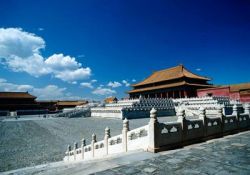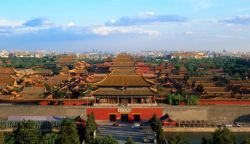Forbidden City
The Forbidden City (紫禁城) was the Chinese imperial palace from the Ming Dynasty to the end of the Qing Dynasty. It is located in the middle of Beijing, and now houses the Palace Museum.
The Forbidden City was included into the UNESCO's World Heritage site in 1987. Today it still abounds with the sense of grandeur and wealth, an aura of pomp and majesty that has passed down through the ages. This secret city was closed off from the world for about 500 years but now 720,000 sq m of courtyards, pavilions, great halls, flourishing gardens and nearly 10,000 rooms combine to form one of the best-preserved historical sites in China. Built by tens of thousands of people, it took over 14 years and 32 million bricks to complete.
Owing its origins to the 24 Ming and Qing dynasty emperors who worked and lived here, few of the original buildings remain. The last emperor Puyi (known in the West for the movie The last Emperor) moved out of this complex in 1925. Today only 1/3 of this palace complex is open to the public. The latest renovations, started in 2002, will soon make it possible to display almost half of the palace by the time of the 2008 Beijing Olympics.
The entire complex sits on a north-south axis, or Meridian line, with halls and houses symmetrically arranged on the side. It consists of three parts: the outer court where the emperor received high officials and administered state affairs; the inner court where the emperor, empress and concubines lived; and the private Imperial Garden for the imperial family to entertain and relax.
The former imperial palace had been closed on Monday afternoons since January 2013. The closure is being extended to cover the whole of Monday for renovation and maintenance. However, the museum will be open on public holidays and Mondays during July and August.

